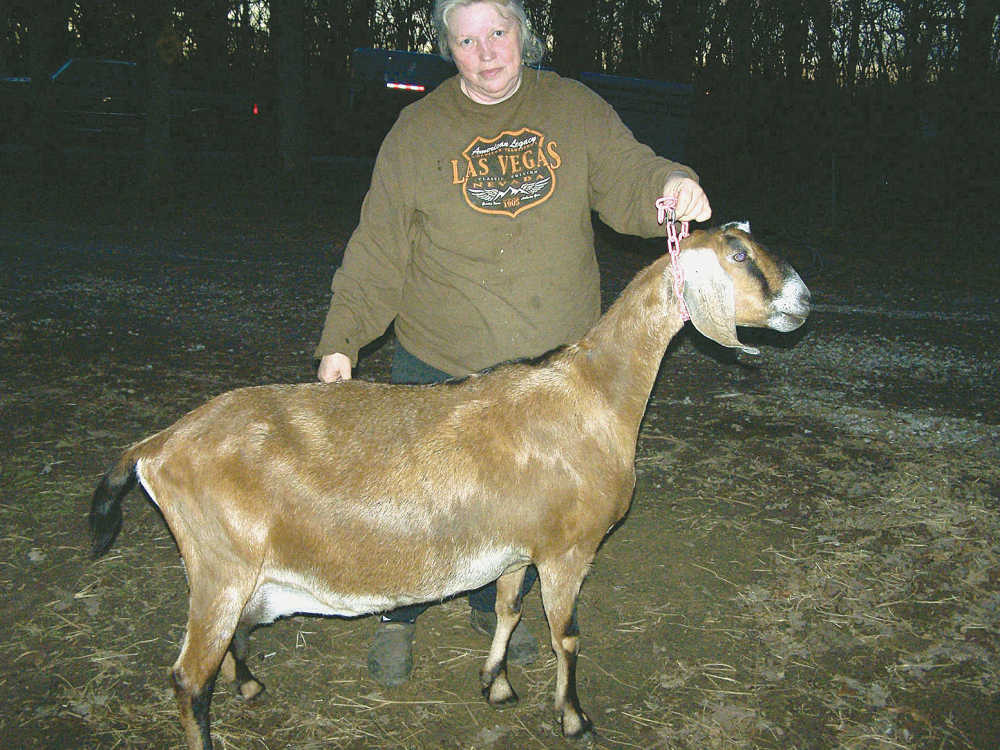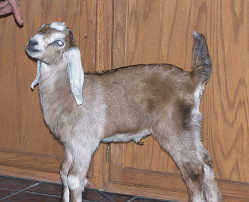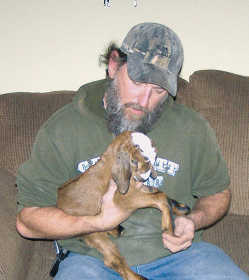Kidding around at Cozy Creek Ranch

Special to the Daily Mail
The playpen in the Cozy Creek Ranch house is full of kids -- but each has four legs! Other baby kids may be running around the ranch house, but it is spotless and there is absolutely no odor.
Ruthie and Shannon Green of rural Nevada raise goats. These are Nubian show goats of high registered pedigrees and superior genetics. A camera trained on the birthing pen sits in the living room where they can keep track of everything going on in the barn. There is heat and air-conditioning in the birthing room for the nanny goat's comfort when she is kidding.
Ruthie, a trained nurse, said, "We are present at every birth."
Shannon added, "The second they are born, I get them into the house. I've run to the barn through the snow in cutoff shorts and T-shirt because we want to get them inside as soon as possible. We don't want the babies to nurse their mothers and ruin their udders."
All of Cozy Creek kids are bottle fed with milk from their mothers, which has been pasteurized to keep any germs from floating around. Also, since the goats are show dairy goats, the rating of the udder is 35 percent out of 100, and nursing would ruin the udder. Another reason to take such excellent care of the kids is most are sold before they are born and the prices begin at $500 and go to $1200.
Cozy Creek goats "ladies', of which they have about 30, kid only once a year. The babies weigh about nine pounds when born, but twins or multiple births weigh 3-4 pounds each. Gestation is three days less than five months. Most births are twins, but some have up to five kids. Ruthie has gotten very good at being able to tell when the birth is about to happen. That way they are prepared. However, they work with their goats daily and when the goat is in heat, they turn it in with the ram. This makes their record keeping pretty accurate.
"Nubians are the Jerseys of the goat world," Shannon explained. "They give almost two gallons of milk a day."
"We have a couple that give that amount," Ruthie said, "but our goal is a gallon a day average. We are on the DHIR milk test program as all our goats are registered. Some of our goats have Milking Stars, which means they gave at least 10 pounds of milk during the testing time, and our butterfat content is better than some Jersey cows. We also do linear appraisal where an impartial trained judge of the breed comes to the farm and judges them. If a judge gives the score of 90, that is awesome, but we have two with a score of 91, and four are over 80 and above. This goes on their permanent records."


Ruthie and Shannon milk their goats by hand until they have 10 to milk and then they use the milking machine. Ruthie said she could milk five goats by hand quicker than Shannon can when using the machine, and then you have to clean the milker. It takes her about 45 minutes to milk nine goats. They milk every 12 hours and test once a month for butterfat and protein. The goats know their names and come when they are called. They walk into the milking stanchion and calmly eat their feed.
"Goats have their own attitudes," Ruthie said, "but they are very good and never kick. They are also very clean. They never go to the bathroom when being milked. If they walk in their feed, they won't eat it, so we keep all hay and feed bunks behind metal panels. They can get their heads through, but can't walk in it and waste it."
Worms are the biggest problems for goats and can kill them if not prevented. The Cozy Creek goats are wormed once a month and also have their hooves trimmed monthly.
Ruthie laughed and said, "Goat milk is the #1 type of milk that is consumed in the world. It's better for you. I love it when people come and tell me when they were little they couldn't drink cow's milk and their parents got a goat. That ought to tell you something."
Because of the melting pot culture of the United States has changed, it has opened new avenues for using goat's milk and cheese. There is a cooking show on television, which uses goat cheese and has increased the demand for it. The Greens drink the raw goat milk themselves and "love it" if they can get any after the babies drink all they need. They freeze milk for wintertime use.
Ruthie makes goat cheese and butter, but also makes soap and lotion from the goat milk.
Goats are supposed to be nature's weed eaters, but not the Cozy Creek goats. They are fed MFA feed with a special 18 percent protein, and good alfalfa hay, which increases the milk supply. However, there is no brush or weeds in the goat pens. Goats are good at cleaning scrub brush, but not these show goats.
Cozy Creek goats are shown nationally. Both Shannon and Ruthie's enthusiasm showed at they told of their goats placements in shows and fairs. "At the show in Louisville in 2014, we had seven girls that placed no lower than eighth place -- and that was in classes of 50. There were 2,500 goats in the show. To even make the cut is very prestigious, but we made it every time."
Ribbons and plaques cover the ranch home at Cozy Creek. One cedar, Missouri-shaped plaque is of special pride because it was won at the Missouri State Fair in 2015 and is for the Best of Show. They also had some Grand Champion ribbons from Sedalia.
After the kids reach the age and weight they can be removed from the house, they go to what they call "The Kidding Room for Teenagers." There they are fed with a five-gallon bucket, which lasts for about two feedings. They are fed on the bucket almost two months and weaned at four months.
If they want to sell any surplus goats, they just put out an ad and they are gone within 48 hours. However, word of mouth is the way most are sold.
"But we can't sell them all," Shannon said. "Then we wouldn't have any for ourselves -- or have any of that good goat milk to drink."
Pride drips from every word Ruthie and Shannon say about their "kids." This is especially true when they tell of the shows and their performance. We can expect more awards in the future for Cozy Creek Goats as they've only been raising them for what they call their "12 year adventure."
